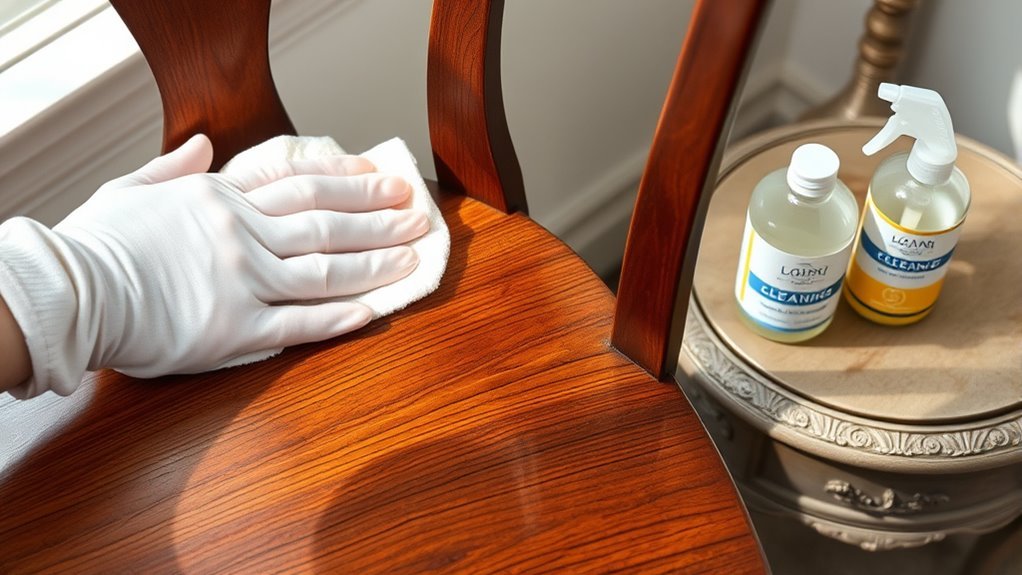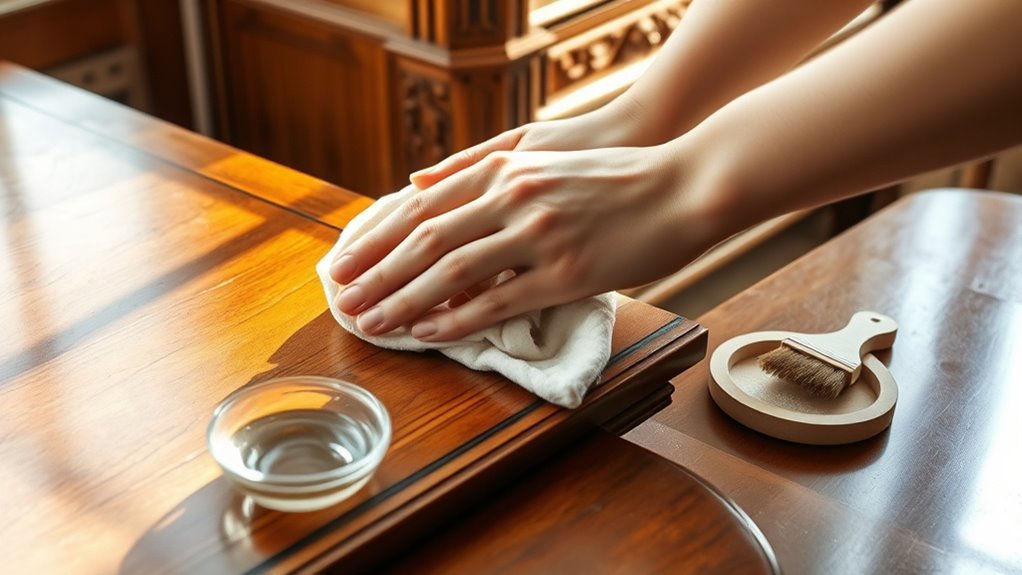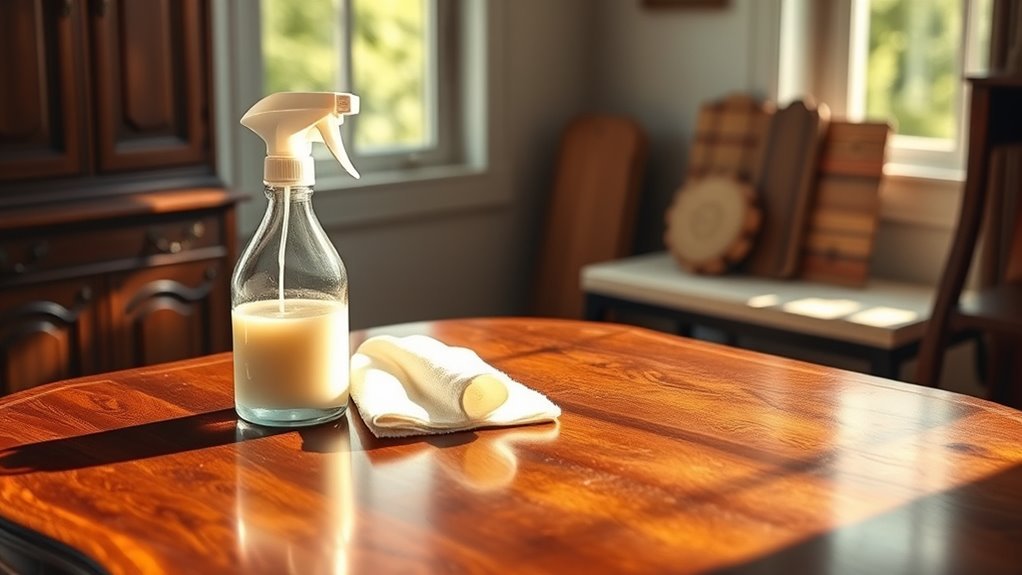How to Safely Clean Antique Furniture Without Damage
To safely clean your antique furniture, start by identifying its finish to choose the right cleaning method. Use soft microfiber cloths and gentle brushes to dust without scratching. Test mild, natural cleaning solutions on hidden spots before applying them. Avoid harsh chemicals and excessive moisture to protect the wood and finish. Handle stains carefully with appropriate, gentle cleaners. Maintaining stable humidity and avoiding direct sunlight also helps preserve your piece. Learn more about essential care steps and techniques to protect your cherished antiques.
Understanding Different Types of Antique Finishes

Before you start cleaning, it’s important to understand the type of finish on your antique furniture. Different finishing techniques, like shellac, lacquer, or wax, each demand unique care to preserve their beauty and integrity. Recognizing these finishes helps you avoid damage and maintain your piece’s value. These finishes aren’t just about looks—they carry historical significance, reflecting the era and craftsmanship of your furniture. When you grasp this, you gain the freedom to clean confidently, knowing you’re respecting the furniture’s story. So, take a moment to identify the finish, whether it’s a hand-applied varnish or a natural oil, before you plunge into cleaning. This understanding is the key to preserving your antique’s charm and legacy.
Essential Tools and Materials for Cleaning Antiques
Knowing the finish on your antique furniture sets the stage for choosing the right cleaning tools and materials. You’ll want gentle cleaning tools paired with soft protective materials to avoid scratches or damage. Here’s a quick guide to essential items:
| Cleaning Tools | Protective Materials |
|---|---|
| Soft microfiber cloths | Cotton gloves |
| Natural bristle brushes | Drop cloth or old sheets |
| Mild soap solution | Protective eyewear |
| Distilled water | Mask (to avoid inhaling dust) |
These tools allow you to clean thoroughly while preserving your piece’s integrity. Using protective materials keeps both your furniture and you safe, letting you enjoy the freedom of maintaining your antiques confidently and effectively.
Preparing Your Antique Furniture for Cleaning

Although it might be tempting to start cleaning right away, you’ll want to prepare your antique furniture properly to avoid any damage. Begin by moving the piece to a well-lit, ventilated space where you have plenty of room to work freely. Inspect the furniture carefully, noting any fragile areas, loose joints, or worn finishes. This step is essential in your antique furniture preparation to guarantee you don’t worsen existing issues. Next, remove any detachable parts like drawers or cushions to clean separately. Always follow cleaning safety precautions by testing your chosen cleaning solution on a hidden spot first, avoiding harsh chemicals that could strip finishes. Taking these steps helps protect your freedom to enjoy your antique’s beauty without risking harm.
Gentle Dusting Techniques for Delicate Surfaces
Once your antique furniture is prepped and any loose parts are set aside, you can focus on dusting the delicate surfaces carefully. Use soft dusting cloths designed for gentle cleaning—microfiber or cotton works best. Avoid harsh brushes; instead, opt for delicate tools like soft-bristled brushes or feather dusters to reach intricate details without scratching. Move slowly and with light pressure, letting the cloth or brush lift dust rather than rubbing aggressively. Don’t rush—this process protects the finish and reveals the wood’s natural beauty. Keep your dusting routine consistent, so dirt doesn’t build up and cause damage. By treating your antique pieces with care through gentle dusting techniques, you preserve their charm and guarantee they remain a source of freedom and joy for years to come.
Safe Cleaning Solutions for Various Wood Types

Because different woods react uniquely to cleaning products, you’ll want to choose solutions that suit the specific type of antique furniture you have. Understanding wood types helps you avoid damage and maintain their natural beauty. Here are some safe cleaning solutions for various wood types:
- Oak and Maple: Use mild dish soap diluted in water; avoid harsh chemicals.
- Mahogany: Opt for a mixture of water and white vinegar for gentle cleaning.
- Walnut: Use a soft cloth with mineral oil to nourish and clean.
- Cherry: Try a solution of water and a few drops of olive oil for a natural shine.
- Pine: Use a gentle wood cleaner designed for softwoods to prevent surface damage.
Choosing the right cleaning solutions guarantees your antique furniture stays as free and vibrant as you want it to be.
Handling Stubborn Stains Without Damaging the Finish
When you spot a stubborn stain, first figure out what caused it to choose the right cleaning method. Always opt for gentle cleaning agents to protect the wood’s finish. Before applying anything, test your solution on a hidden spot to make sure it won’t cause damage.
Identify Stain Type
How do you determine what kind of stain you’re dealing with on your antique furniture? Proper stain identification is essential before attempting any stain removal. Knowing the stain type helps you choose the safest method and protects your piece’s finish.
Look closely for clues like:
- Color and texture of the stain
- Whether the stain feels oily, sticky, or dry
- The stain’s location (surface vs. absorbed)
- Any odor coming from the stain
- Recent spills or environmental factors
Once you’ve identified the stain, you can tailor your stain removal approach without risking damage. This careful observation grants you the freedom to clean confidently, preserving your antique’s beauty and value. Always start gently and test in an inconspicuous spot!
Use Gentle Cleaning Agents
Although stubborn stains can be frustrating, you’ll want to avoid harsh chemicals that might damage your antique’s finish. Instead, opt for gentle cleaning agents made from natural ingredients. These eco friendly solutions not only protect the wood but also respect your commitment to sustainability and freedom from harmful substances. Simple mixtures like diluted white vinegar, lemon juice, or mild castile soap can work wonders without stripping the finish. Apply them sparingly with a soft cloth, gently rubbing the stained area. This approach lets you tackle tough spots carefully, preserving the antique’s beauty and integrity. By choosing these gentle, eco friendly cleaners, you maintain your furniture’s charm while honoring both your values and its delicate surfaces.
Test on Hidden Area
Why risk damaging a visible surface when dealing with stubborn stains? Before applying any cleaning solution, always pick a test area in hidden spots of your antique furniture. This lets you see how the finish reacts without compromising the piece’s beauty. When choosing a test area, consider:
- Select a spot least visible to guests
- Use a cotton swab for precise application
- Wait a few minutes to observe any discoloration
- Try the gentlest cleaner first
- Avoid excessive rubbing to prevent surface damage
Caring for Upholstered Antique Furniture
When caring for upholstered antique furniture, you’ll want to first identify the fabric type to choose the safest cleaning method. Using gentle techniques helps avoid damaging delicate materials. With the right care, you can keep the fabric looking fresh without risking wear or fading.
Identifying Fabric Materials
Before you start cleaning upholstered antique furniture, you’ll want to identify the fabric material to avoid damage. Fabric identification helps you understand the material characteristics, ensuring you choose the safest cleaning approach. To get a clear idea of what you’re dealing with, consider these points:
- Feel the texture: Is it smooth, coarse, or soft?
- Check the weave: Tight or loose patterns can indicate different fibers.
- Look for tags or labels indicating fiber content.
- Test a hidden spot with a small water drop to see absorption.
- Observe colorfastness by gently rubbing with a damp cloth.
Knowing these details gives you the freedom to clean confidently, preserving your antique’s beauty without risk. Accurate fabric identification is your first step to safe, effective care.
Gentle Cleaning Techniques
Although antique upholstery can be delicate, you can still clean it effectively by using gentle techniques tailored to the fabric type. Start by vacuuming with a brush attachment to remove loose dirt without damaging fibers. When spot cleaning, always test a small hidden area first. Use soft cloths dipped in mild, biodegradable cleaners diluted with water to preserve both the fabric and the environment. Gently blot stains instead of rubbing to avoid fiber distortion. Avoid saturating the fabric, as excess moisture can weaken antique upholstery. Let the piece air dry completely in a well-ventilated space away from direct sunlight. By choosing eco-friendly products and handling your antique fabric with care, you’re not just cleaning—you’re respecting its history and ensuring it stays vibrant for years to come.
Preventing Fabric Damage
Taking care during cleaning helps maintain your antique upholstery, but preventing damage goes beyond just washing. To keep your fabric vibrant and intact, focus on preventing fading and protecting seams. Here’s how you can preserve your cherished pieces:
- Avoid direct sunlight to prevent fading and fabric deterioration.
- Use gentle, fabric-safe cleaners to protect fibers without harsh chemicals.
- Regularly vacuum with a soft brush to remove dust without stressing seams.
- Rotate cushions and pillows to distribute wear evenly and avoid seam strain.
- Address stains promptly with spot cleaning to minimize fiber damage.
Tips for Maintaining Antique Furniture After Cleaning
Once you’ve cleaned your antique furniture, it’s important to protect it from damage and wear to keep it looking its best. Start by applying a high-quality furniture polish to nourish the wood and enhance its natural beauty. Avoid products with harsh chemicals that can strip finishes. Next, keep your furniture in an environment with stable humidity levels—ideally between 40-55%—to prevent wood from cracking or warping. Using a humidifier or dehumidifier can help maintain this balance. Also, place your pieces away from direct sunlight and heat sources to prevent fading and drying out. Finally, handle your antiques gently and dust them regularly with a soft cloth. With these steps, you’ll preserve your furniture’s charm and enjoy its freedom from damage for years to come.
Frequently Asked Questions
Can Cleaning Antique Furniture Increase Its Value?
You might think cleaning antique furniture will magically turn it into a priceless treasure overnight! While it won’t create gold, using proper restoration techniques can definitely boost its appeal. When you pair careful cleaning with a professional value assessment, you’re releasing your piece from dust’s dull grip and potentially increasing its market worth. Just avoid overdoing it—preserving that authentic charm is key to truly revealing its value and your freedom to enjoy it.
How Often Should Antique Furniture Be Professionally Restored?
You shouldn’t stick to a strict restoration frequency for your antique furniture. Instead, rely on a professional assessment to determine when it truly needs attention. This way, you’re not overdoing it or risking damage by restoring too often. Trusting experts lets you keep your pieces in great shape while maintaining their character and value, giving you the freedom to enjoy your antiques without unnecessary worry or expense.
Is It Safe to Use Commercial Furniture Polish on Antiques?
Imagine your antique furniture as a delicate butterfly—you wouldn’t want to trap it in a sticky net. Using commercial polish might seem tempting, but it can harm antique finishes, stripping their unique glow. You’re better off choosing gentle, specialized products that respect the piece’s history. By avoiding harsh chemicals, you keep your freedom to enjoy its original beauty without risk, letting your furniture breathe and shine naturally for years to come.
What Are the Signs of Over-Cleaning Antique Wood?
If you’re wondering about over cleaning indicators on your antique wood, watch for dullness, a sticky feel, or fading finish—that’s a sign you’ve gone too far. Over cleaning can strip away the natural oils, causing antique wood deterioration like cracks or warping. You don’t want to cage your furniture’s character; instead, aim to preserve its charm by being gentle and mindful with each clean.
How Should I Store Antique Furniture to Prevent Damage?
You’ll want to store your antique furniture in a space with proper climate control to avoid extreme humidity or temperature changes, which can cause warping or cracking. Using breathable protective covers helps shield your pieces from dust and accidental scratches without trapping moisture. Keeping your furniture away from direct sunlight and vents will also preserve its finish. By managing these factors, you’ll keep your antiques looking great and maintain their freedom to shine for years.






